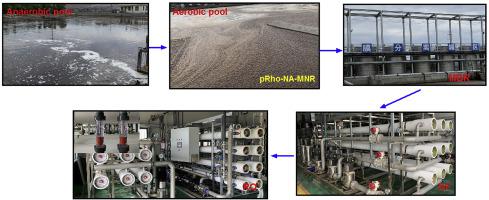当前位置:
X-MOL 学术
›
Environ. Pollut.
›
论文详情
Our official English website, www.x-mol.net, welcomes your
feedback! (Note: you will need to create a separate account there.)
Landfill leachate treatment through the combination of genetically engineered bacteria Rhodococcus erythropolis expressing Nirs and AMO and membrane filtration processes.
Environmental Pollution ( IF 7.6 ) Pub Date : 2020-01-23 , DOI: 10.1016/j.envpol.2020.114061 Fuliang Bai 1 , Hui Tian 2 , Jun Ma 3
Environmental Pollution ( IF 7.6 ) Pub Date : 2020-01-23 , DOI: 10.1016/j.envpol.2020.114061 Fuliang Bai 1 , Hui Tian 2 , Jun Ma 3
Affiliation

|
This study developed a process of genetically engineered bacteria Rhodococcus erythropolis expressing Nirs and AMO combined with membrane bioreactor (MBR), nanofiltration (NF) and reverse osmosis (RO) membrane (pRho-NA-MNR) for advanced treatment of landfill leachate. Results demonstrated that pRho-NA-MNR presented higher removal rate of chemical oxygen demand (COD), biological oxygen demand (BOD), ammonia nitrogen (N-NH4), total nitrogen (TN) and total organic carbon (TOC) than activated sludge (AS-MNR) system. Administration of pRho-NA increased nitrification by converting N-NH4 to nitrite (N-NO2) and Nitrate (N-NO3), and promoting denitrification by converting N-NO2 to nitrogen (N2) in the landfill leachate treatment, promoted the pH control, increased sludge activity and effluent yield, shortened phase length adaptation under alternating aerobic-anoxic conditions. pRho-NA increased the nitration and denitrifying rate in the aerobic and anaerobic stage in the system by increasing Cyt cd1 and Cyt c expression in the activated sludge. Nitrogen removal by nitrification and denitrification was positively correlated to the concentration of Nirs and AMO expression. Treatment with pRho-NA promoted pollutant removal efficiency of membrane bioreactor, nanofiltration and reverse osmosis membrane processes in landfill leachate. In conclusion, data suggest that pRho-NA-MNR facilitates the formation of granular sludge and enhances comparable removal of nitrogen and organic compounds, indicating the practice of this process should be considered in landfill leachate treatment system.
中文翻译:

通过表达Nirs和AMO的转基因细菌红球菌红球菌和膜过滤工艺的组合来处理垃圾渗滤液。
这项研究开发了一种表达Nirs和AMO的基因工程细菌红球红球菌与膜生物反应器(MBR),纳滤(NF)和反渗透(RO)膜(pRho-NA-MNR)相结合的工艺,用于垃圾渗滤液的深度处理。结果表明,与活性污泥相比,pRho-NA-MNR的化学需氧量(COD),生物需氧量(BOD),氨氮(N-NH4),总氮(TN)和总有机碳(TOC)的去除率更高。 (AS-MNR)系统。施用pRho-NA可通过将N-NH4转化为亚硝酸盐(N-NO2)和硝酸盐(N-NO3)来增加硝化作用,并通过在垃圾渗滤液处理中将N-NO2转化为氮(N2)来促进反硝化作用,从而促进了pH值控制,增加了污泥活性和废水产量,在交替的有氧-缺氧条件下缩短了相长适应。pRho-NA通过增加活性污泥中Cyt cd1和Cyt c的表达来提高系统好氧和厌氧阶段的硝化和反硝化率。通过硝化和反硝化去除的氮与Nirs的浓度和AMO表达呈正相关。pRho-NA处理提高了垃圾渗滤液中膜生物反应器的污染物去除效率,纳滤和反渗透膜工艺。总之,数据表明,pRho-NA-MNR促进了颗粒污泥的形成,并提高了氮和有机化合物的可比去除率,这表明在垃圾填埋场渗滤液处理系统中应考虑该过程的实践。pRho-NA通过增加活性污泥中Cyt cd1和Cyt c的表达来提高系统好氧和厌氧阶段的硝化和反硝化率。通过硝化和反硝化去除的氮与Nirs的浓度和AMO表达呈正相关。pRho-NA处理提高了垃圾渗滤液中膜生物反应器的污染物去除效率,纳滤和反渗透膜工艺。总之,数据表明,pRho-NA-MNR促进了颗粒污泥的形成,并提高了氮和有机化合物的可比去除率,这表明在垃圾填埋场渗滤液处理系统中应考虑该过程的实践。pRho-NA通过增加活性污泥中Cyt cd1和Cyt c的表达来提高系统好氧和厌氧阶段的硝化和反硝化率。通过硝化和反硝化去除的氮与Nirs的浓度和AMO表达呈正相关。pRho-NA处理提高了垃圾渗滤液中膜生物反应器的污染物去除效率,纳滤和反渗透膜工艺。总之,数据表明,pRho-NA-MNR促进了颗粒污泥的形成,并提高了氮和有机化合物的可比去除率,这表明在垃圾填埋场渗滤液处理系统中应考虑该过程的实践。通过硝化和反硝化去除的氮与Nirs的浓度和AMO表达呈正相关。pRho-NA处理提高了垃圾渗滤液中膜生物反应器的污染物去除效率,纳滤和反渗透膜工艺。总之,数据表明,pRho-NA-MNR促进了颗粒污泥的形成,并提高了氮和有机化合物的可比去除率,这表明在垃圾填埋场渗滤液处理系统中应考虑该过程的实践。通过硝化和反硝化去除的氮与Nirs的浓度和AMO表达呈正相关。pRho-NA处理提高了垃圾渗滤液中膜生物反应器的污染物去除效率,纳滤和反渗透膜工艺。总之,数据表明,pRho-NA-MNR促进了颗粒污泥的形成,并提高了氮和有机化合物的可比去除率,这表明在垃圾填埋场渗滤液处理系统中应考虑该过程的实践。
更新日期:2020-04-20
中文翻译:

通过表达Nirs和AMO的转基因细菌红球菌红球菌和膜过滤工艺的组合来处理垃圾渗滤液。
这项研究开发了一种表达Nirs和AMO的基因工程细菌红球红球菌与膜生物反应器(MBR),纳滤(NF)和反渗透(RO)膜(pRho-NA-MNR)相结合的工艺,用于垃圾渗滤液的深度处理。结果表明,与活性污泥相比,pRho-NA-MNR的化学需氧量(COD),生物需氧量(BOD),氨氮(N-NH4),总氮(TN)和总有机碳(TOC)的去除率更高。 (AS-MNR)系统。施用pRho-NA可通过将N-NH4转化为亚硝酸盐(N-NO2)和硝酸盐(N-NO3)来增加硝化作用,并通过在垃圾渗滤液处理中将N-NO2转化为氮(N2)来促进反硝化作用,从而促进了pH值控制,增加了污泥活性和废水产量,在交替的有氧-缺氧条件下缩短了相长适应。pRho-NA通过增加活性污泥中Cyt cd1和Cyt c的表达来提高系统好氧和厌氧阶段的硝化和反硝化率。通过硝化和反硝化去除的氮与Nirs的浓度和AMO表达呈正相关。pRho-NA处理提高了垃圾渗滤液中膜生物反应器的污染物去除效率,纳滤和反渗透膜工艺。总之,数据表明,pRho-NA-MNR促进了颗粒污泥的形成,并提高了氮和有机化合物的可比去除率,这表明在垃圾填埋场渗滤液处理系统中应考虑该过程的实践。pRho-NA通过增加活性污泥中Cyt cd1和Cyt c的表达来提高系统好氧和厌氧阶段的硝化和反硝化率。通过硝化和反硝化去除的氮与Nirs的浓度和AMO表达呈正相关。pRho-NA处理提高了垃圾渗滤液中膜生物反应器的污染物去除效率,纳滤和反渗透膜工艺。总之,数据表明,pRho-NA-MNR促进了颗粒污泥的形成,并提高了氮和有机化合物的可比去除率,这表明在垃圾填埋场渗滤液处理系统中应考虑该过程的实践。pRho-NA通过增加活性污泥中Cyt cd1和Cyt c的表达来提高系统好氧和厌氧阶段的硝化和反硝化率。通过硝化和反硝化去除的氮与Nirs的浓度和AMO表达呈正相关。pRho-NA处理提高了垃圾渗滤液中膜生物反应器的污染物去除效率,纳滤和反渗透膜工艺。总之,数据表明,pRho-NA-MNR促进了颗粒污泥的形成,并提高了氮和有机化合物的可比去除率,这表明在垃圾填埋场渗滤液处理系统中应考虑该过程的实践。通过硝化和反硝化去除的氮与Nirs的浓度和AMO表达呈正相关。pRho-NA处理提高了垃圾渗滤液中膜生物反应器的污染物去除效率,纳滤和反渗透膜工艺。总之,数据表明,pRho-NA-MNR促进了颗粒污泥的形成,并提高了氮和有机化合物的可比去除率,这表明在垃圾填埋场渗滤液处理系统中应考虑该过程的实践。通过硝化和反硝化去除的氮与Nirs的浓度和AMO表达呈正相关。pRho-NA处理提高了垃圾渗滤液中膜生物反应器的污染物去除效率,纳滤和反渗透膜工艺。总之,数据表明,pRho-NA-MNR促进了颗粒污泥的形成,并提高了氮和有机化合物的可比去除率,这表明在垃圾填埋场渗滤液处理系统中应考虑该过程的实践。










































 京公网安备 11010802027423号
京公网安备 11010802027423号